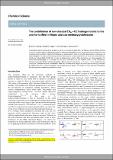The contribution of non-classical CHax∙∙∙OC hydrogen bonds to the anomeric effect in fluoro and oxa-methoxycyclohexanes
Abstract
In this theory study we demonstrate the dominance of non-classical 1,3-diaxial CHax∙∙∙OC hydrogen bonds (NCHBs) dictating a ‘pseudo‘ anomeric effect in selectively fluorinated methoxycyclohexanes and also influencing the axial preference in the classical anomeric exhibitor 2-methoxytetrahydropyran, a phenomenon which is most often described as a consequence of hyperconjugation. Analogues of methoxycyclohexane where ring CH2’s are replaced by CF2 can switch to an axial preference and theory methods (NBO, QTAIM, NCI) indicate the dominance of 1,3- CHax∙∙∙OMe interactions over hyperconjugation. For 2-methoxytetrahydropyran, it is revealed that the global contribution to the anomeric effect is from electrostatic interactions including NCHBs, not hyperconjugation, although hyperconjugation (nO→σ *CO or nO →σ*CC) remains the main contributor to the exo-anomeric phenomenon. When two and three ether oxygens are introduced into the ring, then both the NCHB interactions and hyperconjugative contributions become weaker, not stronger as might have been anticipated, and the equatorial anomers progressively dominate.
Citation
Piscelli , B , O'Hagan , D & Cormanich , R 2021 , ' The contribution of non-classical CH ax ∙∙∙OC hydrogen bonds to the anomeric effect in fluoro and oxa-methoxycyclohexanes ' , Physical Chemistry Chemical Physics , vol. 23 , no. 10 , pp. 5845-5851 . https://doi.org/10.1039/D0CP06646J
Publication
Physical Chemistry Chemical Physics
Status
Peer reviewed
ISSN
1463-9076Type
Journal article
Description
Authors thank FAPESP, CONFAP and The UK Academies FAPESP for a São Paulo International Research Collaboration (FAPESP #2019/05028-7). FAPESP is also gratefully acknowledge for an undergraduate fellowship to BAP (#2019/03855-3), and a Young Research Award to RAC (#2018/03910-1). CENAPAD-SP, CESUP and SDumont are acknowledged for computational resources used in the theory calculations. We also thank EPSRC for a grant (EP/S030506/1).Collections
Items in the St Andrews Research Repository are protected by copyright, with all rights reserved, unless otherwise indicated.

